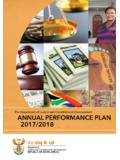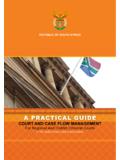Transcription of Vote 21 Justice and Constitutional Development
1 425 Vote 21 Justice and Constitutional Development Budget summary 2018/19 2019/20 2020/21 R million Total Current payments Transfers and subsidies Payments for capital assets Total Total MTEF allocation Administration 2 2 2 2 Services 6 5 6 7 Legal Services 1 1 1 1 Prosecuting Authority 3 3 3 4 and Associated Services 3 3 3 17 13 18 19 charge against the National Revenue Fund Magistrates salaries 2 2 2 2 expenditure estimates 19 15 20 21 authority Minister of Justice and Correctional Services Accounting officer Director General of Justice and Constitutional Development Website address The Estimates of National Expenditure e-publications for individual votes are available on These publications provide more comprehensive coverage of vote specific information, particularly about goods and services, transfers and subsidies, personnel, entities, donor funding, public private partnerships, conditional grants to provinces and municipalities, and expenditure information at the level of service delivery, where appropriate.
2 Vote purpose Uphold and protect the Constitution and the rule of law, and render accessible, fair, speedy and cost-effective administration of Justice in the interests of a safer and more secure South Africa. Mandate The Department of Justice and Constitutional Development derives its mandate from a number of acts, in addition to the mandate it derives from the Constitution. These acts and the Constitutional framework assign functions to the department, such as: the establishment of magistrate s courts, and the appointment of magistrates and other judicial officers; the establishment and functioning of the Special Investigating Unit and the National Prosecuting Authority, including the asset forfeiture unit; the conducting of criminal proceedings; the prosecution of organised crime and corruption, and the forfeiture of assets obtained through illicit means; the provision of witness protection to vulnerable and intimidated witnesses and their related persons in judicial proceedings; the establishment and functioning of bodies responsible for legal aid, law reform and rule making; the appointment of masters of the high courts.
3 The administration of the Guardian s Fund and deceased and insolvent estates; the regulation and provision of legal advisory services to government departments; the promotion, protection and enforcement of certain human rights; the protection of vulnerable groups; the management of third-party funds; and the provision of support to chapter 9 institutions. 2018 Estimates of National Expenditure 426 Selected performance indicators Table Performance indicators by programme and related outcome Indicator Programme MTSF outcome Past Current Projections 2014/15 2015/16 2016/17 2017/18 2018/19 2019/20 2020/21 Number of criminal cases on the backlog roll in the lower courts per year Court Services Outcome 3: All people in South Africa are and feel safe 29 480 47 324130 925 30 344 43 500 42 63041 760 Number of courtrooms adapted in line with the sexual offences model per year Court Services 141411172 14 1618 Percentage of letters of appointment issued in deceased estates within 15 days from receipt of all required documents State Legal Services 89%(103 904/116 746)93%(139 500/150 000)96%(135 315/140 412)92% 92% 93%94%Conviction rate3.
4 - High courts - Regional courts - District courts National Prosecuting Authority 91%(890/978)77%(25 591/33 430)94%(268 127/284 741)89%(910/1 021)78%(24 958/31 834)95%(263 377/278 117)91%(968/1 065)80%(25 209/31 608)96%(295 013/308 688) 87% 74% 88% 87% 74% 88% 87%74%88%87%74%88%Number of victims assisted at Thuthuzela care centres National Prosecuting Authority 4 4 4 4 29 800 29 86029 920 Conviction rate in cases reported at Thuthuzela care centres5 National Prosecuting Authority 65%(1 563/2 285)72%(1 679/2 340)71%(1 659/2 334)68% 68% 68%68%Total number of persons convicted of corruption or offences related to corruption where the amount involved is more than R5m National Prosecuting Authority 234877 106 129 149169 Value of completed forfeiture cases per year6 National Prosecuting Authority R245m R282m R311mR311mValue of freezing orders per year6 National Prosecuting Authority R789m R1bnR1bnSuccess rate of litigated cases7 National Prosecuting Authority 94%(204/216)96%(393/411)99%(554/560)93% 93% 93%93%1.
5 Until 2014, backlog cases were described as those matters on the roll without finalisation longer than 6 months in the district courts, 9 months in the regional courts and 12 months in the higher courts. However, in practice, many cases remained for a considerable period in the district court before they were ready for trial in the regional or high court forums, and were not counted as backlogs while they were in the district courts as the backlog definition indicated time in a particular court forum. Following the publication in the Government Gazette on 28 February 2014 of judicial norms and standards binding on all courts issued by the chief Justice , matters had to be measured from the date of first appearance in the magistrate s court. This required a change in calculation methodology, which led to a large increase in matters to be described as backlogged.
6 The 47 324 cases then formed the new baseline for cases outstanding for a long time on the court roll. With the new case backlog calculation methodology implemented, the department conducted data cleansing and captured backlogged information to ensure data integrity. The reduced number of cases at the end of 2016/17 indicated the cleansed data at that point. However, it is clear that further cleansing is required in terms of capturing backlogged data on the system. The targets for 2018/19, 2019/20 and 2020/21 reflect the higher baseline numbers as reflected in 2015/16, which remains the baseline. 2. Target increases for 2017/18 as these courts are set to be upgraded based on the model specified as per the minimum standards for the establishment of the sexual offences courts, which have fewer and more affordable infrastructure specifications.
7 Over the MTEF period, targets are aligned with the available budget. 3. Targets for this indicator are based on the National Prosecuting Authority s norms and standards, and not historical performance. 4. No historical data available. 5. Old indicator selected for publication in the Estimates of National Expenditure. 6. Fluctuations in the value of completed forfeiture cases and freezing orders occur depending on when big cases are finalised. 7. The decrease in the annual success rate over MTEF period is due to a stronger focus on cases with significant impact that the unit has a higher risk of losing. Expenditure analysis The National Development Plan (NDP) envisages that, by 2030, all South Africans should feel safe at home, at school and at work, and enjoy a community life free of fear. This vision is expressed in terms of outcome 3 (all people in South Africa are and feel safe) of government s 2014-2019 medium-term strategic framework, with which the work of the Department of Justice and Constitutional Development is closely aligned.
8 Over the medium term, the department intends to focus on: strengthening its efforts to transform the Justice system through developing and implementing policies that will bring about improved access to Vote 21: Justice and Constitutional Development 427justice, improving the efficiency of the criminal Justice system through modernising and integrating information systems and related business processes, transforming state legal services to strengthen the capability of the state to manage litigation, and protecting vulnerable groups. The administration of Justice is labour intensive. Accordingly, spending on compensation of employees remains the department s main cost driver, increasing at an average annual rate of per cent over the MTEF period, from billion in 2017/18 to billion in 2020/21. However, the department s staff complement is expected to decrease by 206 over the same period, from 24 094 in 2017/18 to 23 888 in 2020/21, in line with government s expenditure ceiling for compensation of employees.
9 The department established a review committee in 2016/17 to consider the filling of critical posts. The committee will remain active until the department s budget for compensation of employees is stable. Improving access to Justice The department s legislative mandate provides for a high court in every province. With the exception of Mpumalanga, all provinces now have a high court. The construction of the Mpumalanga high court was expected to be completed in 2017/18, but the late finalisation of intergovernmental negotiations regarding the access road to the court has delayed the project s completion. The project is expected to be completed in 2018/19 at a total estimated cost of billion. To operationalise the court, a total of million was reprioritised within the vote over the MTEF period through the reduction of funded magistrate positions, to fund added capacity in Legal Aid South Africa in the Auxiliary and Associated Services programme, and the National Prosecuting Authority in the National Prosecuting Authority programme.
10 These reprioritised funds are expected to be used to appoint 8 prosecutors and 3 administrative personnel in the National Prosecuting Authority, while Legal Aid South Africa plans to employ 1 legal practitioner and 1 paralegal practitioner. An additional million is transferred to the Office of the Chief Justice over the medium term for the same purpose, along with R36 million for consequential costs relating to judicial appointments. Other court infrastructure projects prioritised for completion in 2018/19, at a total projected cost of billion, are in Port Shepstone (KwaZulu-Natal), Cape Town and Plettenberg Bay (Western Cape), Booysens and Mamelodi (Gauteng), Bityi and Dimbaza (Eastern Cape), Fraserburg (Northern Cape) and Welkom (Free State). The construction of additional courts will be supplemented by aligning the districts and jurisdiction of magistrate s courts with municipal boundaries to ensure that all people have equitable access to Justice wherever they live.

















